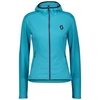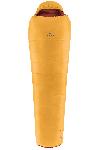Monte Rosa: twenty years of research by Ferrino
Up there, on Monte Rosa, tents made by Ferrino are subjected to an extreme stress test:prolonged exposure to radiation from the sun. UV rays are not only harmful to human tissue, they also damage synthetic fabrics due to photo ageing. Twenty years of high-altitude study, observation and scientific research have transformed mountain tents into the most sophisticated high-tech products with the ability to withstand the worst possible conditions. Every day, qualified people check the materials, and record the different climate data (temperature, wind, humidity, UV rays, etc...), so as to be able to study reactions to different climate situations and to take note of the feedback from those who actually use this equipment.
Silvio "Gnaro" Mondinelli can bear witness to this. He is one of the few climbers in the world to have summited all fourteen of the globe’s highest peaks – almost always using Ferrino tents –summiting without the use of additional oxygen. "I was in a Ferrino tent," Gnaro remembers, "when I was experiencing survival at its very limits at an altitude of 7000 metres. If I managed to survive the polar storms and blizzards, then it is also thanks to the strength and resistance of those ‘eagles’ nests’ that protected and saved me". Gnaro tells us more about his nights in a Ferrino tent, "as light as a cocoon". Or with "silvered sides to protect against the ultraviolet rays." Or "in the shape of a space shuttle, like Colle Sud, where the fastenings had to deal with winds of up to 100 kilometres per hour on the 8000-metre peaks of Everest and K2".
Or Mike Horn, who in 2002 crossed the Arctic, spending the nights inside his M.H.L. Evolution tent, tested in the wind tunnel at Mercedes so that it could withstand the 150 km/h winds.
"Those of us who actually make high-altitude equipment," says CEO Anna, fifth generation Ferrino in the company – field testing is the central element. And the field can only be the top of a mountain. But that doesn’t mean we don’t focus on other research and development stages".
One such example of this is W.T.S. (Welded Technical System) technology, which has replaced the use of sewn seams and was developed thanks to tests carried out in the HighLab field before being applied to the EMPEROR tent in 2010 (making this the first seam-free tent by Ferrino). These tests showed how taped seams on a tent, when subjected to UV rays for long periods, undergo changes that lead the taping to come away from the inside of the fabric, which may then lead to water leakages and a resulting need for repairs. On the other hand, W.T.S. technology, field tested at HighLab, was able to overcome this problem, allowing Ferrino to offer a cutting-edge product. The following year, the very same technology was applied to the line of HL Revolution W.T.S. sleeping bags, which has welded channels that as well as preventing heat dispersion, also stop the down filling from escaping, as it would through normal seams. This line of sleeping bags also has a patented technology that combines W.T.S. with the use of stretch thread to offer even better comfort (up to 15% more available space compared to a standard sleeping bag).
But Ferrino doesn’t intend to stop at "simple" tests, even though there is nothing very simple about the tests in question - given their extreme nature; the company wants to go beyond this, giving everyone the chance to live a "real life" experience at a real base camp while at the same time, to contribute to improvements in materials by providing their own feedback. Yes, you read that right. Ferrino is offering the chance, together with the Quintino Sella Refuge in Felik, to spend a different kind of holiday, breaking away from the monotony of the usual package tour, crowded places and classical popular summer holiday destinations.
Ferrino wants to give you the chance to experience the thrill of seeing the sunrise and sunset from a new perspective, to watch the mountains change colour, from pink, to blinding white and to fire red, while listening to the deafening sound of the silence. You could watch infinity right before your eyes, only broken up by the mountain crests of the Alps; or you could become enveloped in a sea of clouds that might disappear in an instant to show you a magnificent area that never changes but which never stays the same...
Ferrino wants you to try these new experiences, new emotions that not everyone has been able to enjoy and which perhaps some of you have read about in interviews with the world’s best mountaineers, wondering what it must be like "to be inside a tent at 4000 metres."
Now all you have to do is pack up your backpack, put it on your shoulders and go up to the HighLab Ferrino base camp, where you can be transported to a new dimension and have – at least once in your life – a holiday that is out of the ordinary.
Just one thing – a thank you before closing the tent to go back to the "normal world" may be worth more than a whole lot of tests.
PRACTICAL INFO:
Contacts and information:
E-mail: info@rifugioquintinosella.com
Tel.: +39 0125 366113 / GSM +39 348 8107793
Reservations: to be made on the refuge website, at the following: www.rifugioquintinosella.com
GPS: 45°54'03.8"N 7°47'33.9"E
The Quintino Sella Refuge at Felik is on the Italian side of the Monte Rosa massif, at an altitude of 3,585 metres. It is at the end of a beautiful trail that crosses the Gressoney or Ayas valleys.
The refuge is the starting point for the ascent to Castore, one of the more accessible 4000-metre peaks in the Alps, as well as an essential stage in the Tour del Monte Rosa, which crosses the whole mountain chain at high altitude, for the ascent of Lyskamm Occidentale and crossing Lyskamm Orientale.
How to reach the refuge:
The main access to the refuge is Valle di Gressoney, Valle d'Aosta. A lift will take you from Stafal to Colle Bettaforca, at 2,670 m, about 3 hours from the refuge, which can also be reached from Val d'Ayas using an off-road vehicle service to Colle Bettaforca or on foot (6-hour walk).
From Milan
A4 motorway: Milan - Turin - Santhià - Ivrea - Aosta – Exit at Pont-Saint-Martin and continue for 34 km in the direction of Gressoney-La-Trinité, località Stafal.
From Turin
A5 motorway Ivrea - Aosta – Exit at Pont-Saint-Martin and continue for 34 km in the direction of Gressoney-La-Trinité, località Stafal.
From Genoa
A26 motorway Genoa - Alexandria - Santhià - Aosta - and continue for 34 km in the direction of Gressoney-La-Trinité, località Stafal.
From Champoluc - Ayas
Exit at Verrès. Take the road to Val d'Ayas for 32 km as far as Saint-Jacques, which is the starting point for the trail up to Colle Bettaforca. Continue up to the refuge (approx. 6 hours). There is an offroad vehicle taxi service (booking required -La Carrozza 335-6626748). Important: the roads to Colle Bettaforca and Pian di Verra are closed to all unauthorised motor vehicles.
From Gressoney-La-Trinité
Starting from the chief town of Gressoney-La-Trinité, continue for about 4 km, arriving in Stafal, where the asphalt road covering ends. The lifts up to Colle della Bettaforca at 2.680 metres about sea level are reached from the car park, as far as trail 9, which is marked with yellow trail markers.
The first section of the trail, as far as Colle Bettolina at 3,100 m, is very accessible. It carries on becoming steeper and crossing scree, as far as the cairn on the top. At the start of the season and until the end of July, this section is generally covered with snow, but given the amount of excursionists, the route is usually well marked.
The last section consists of a crest that is aerial in parts (about 30-40 minutes), and this is well tooled, with a fixed rope to secure yourself.
The time needed to reach the refuge (for mid-level trained athletes) varies from 3 to 4 hours.
Colle Bettaforca lift times, 2014
Lifts are open every day from 28 June to 07 September from Gressoney-La-Trinité.
Summer opening times: 7.30 to 12.30 and from 14.15 to 17.00 (last journey). A return trip costs 17.00 Euro per person (discount for organised groups of over 25 people).
Always check the times and prices for the lifts on the refuge website www.rifugioquintinosella.com


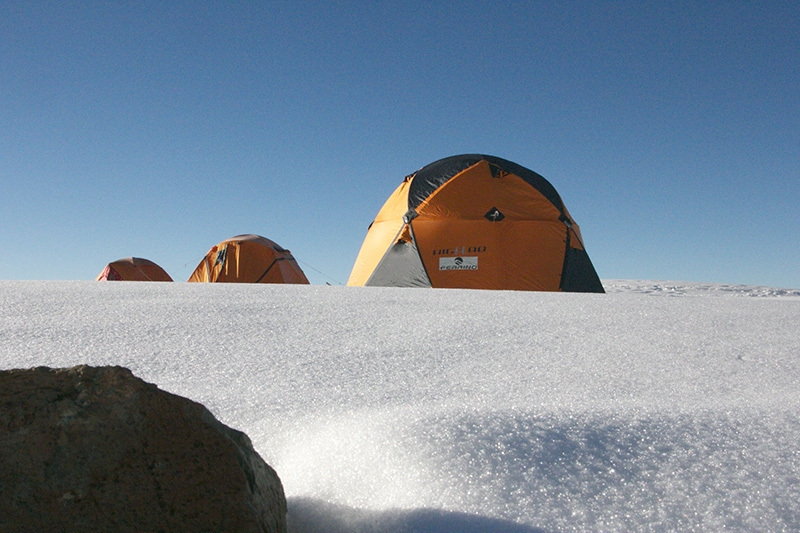
 1 / 10
1 / 10
 Copia link
Copia link

 Ferrino
Ferrino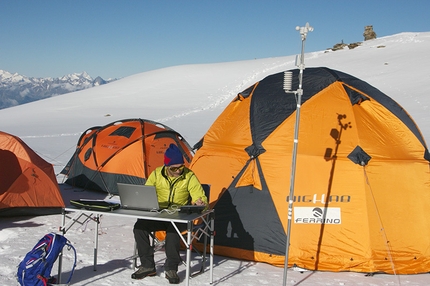
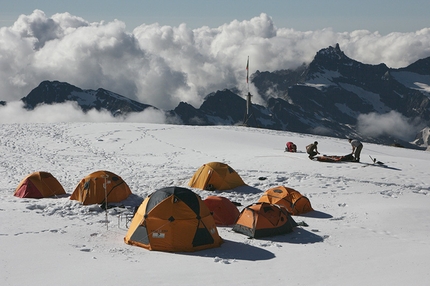
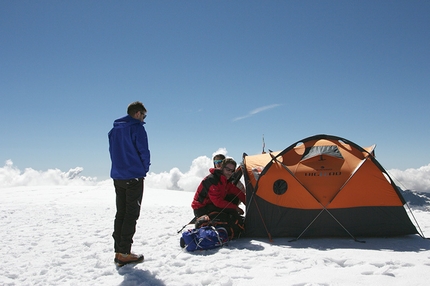
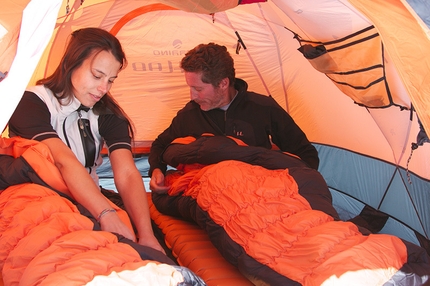
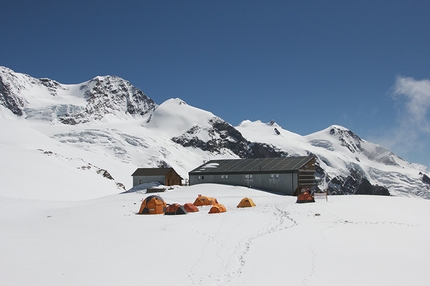
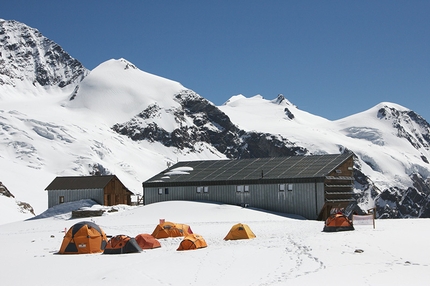
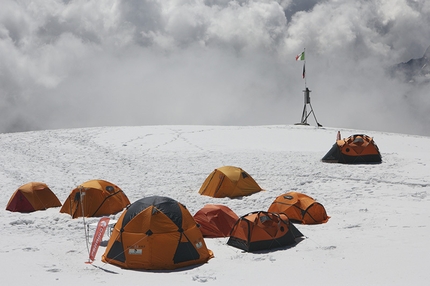
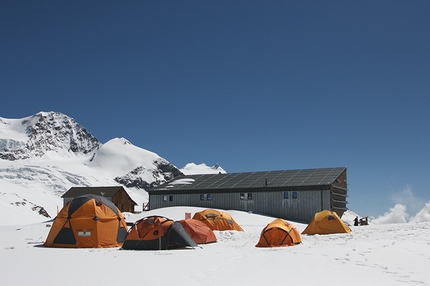
 See all photos
See all photos















